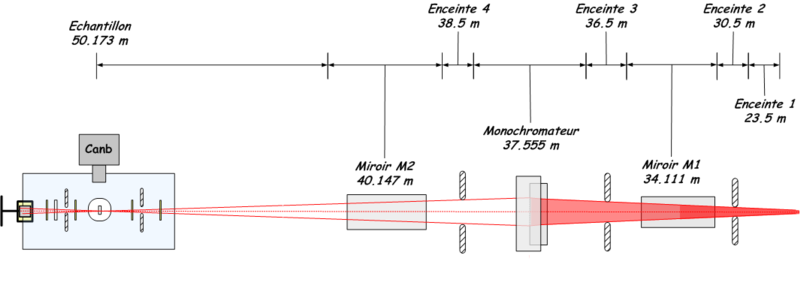FAME, the French Absorption spectroscopy beamline in Material and Environmental science, is dedicated to X-ray absorption spectroscopy. FAME covers a wide variety of scientific fields (materials science, biophysics, chemistry) but focuses mainly in geochemical sciences where, in most cases, the probed elements are highly diluted.
FAME being a bending magnet beamline, the optical elements have been designed in order firstly to maximize the photon flux on the sample and secondly to optimize the beamline stability and reduce the non-statistical noise (Proux et al. Journal of Synchrotron Radiation 13 (2006) 59-68). Moreover, for an optimal acquisition of XAS spectra on diluted elements, the intense x-ray beam on the sample needs to be associated with a highly sensitive detection system: fluorescence detection is achieved with a 16-element Mirion Ge solid state detector.
Opened to users since 2002, the beamline offers several sample environments, either to improve the measurements (helium cryostat), either to carry out in-situ measurements (HP-HT vessel, gaseous cell), and can accept many other apparatus.
FAME is one of the French CRG beamlines at the ESRF: beamtime can be asked boththrough the ESRF and the Soleil program committees.
0.8T ESRF BM
FAME monochromator
EXAFS
Transmission detection mode
Sample
Manipulator or Sample stage
Sample Environment
Fluorescence detection mode
Detection
Transmission detection mode
Detection
- EXAFS
- NEXAFS
- X-ray fluorescence (XRF)
- Biochemistry
- Catalysis
- Electrochemistry
- Green Chemistry
- Physical Chemistry
- Geology
- Mineralogy
- Natural disaster, Desertification & Pollution
- Plant science
- Water sciences/Hydrology
- Sustainable energy systems
- Cultural Heritage
- Molecular and cellular biology
- Other - Material Sciences
- Hard condensed matter - structures
- BLISS
- spectra (X: Energy, Y: absorption in fluorescence, transmission, temperature of measurement...)
- HDF5
- Larix (XAS normalization and EXAFS analysis) , FDMNES (XANES analysis)
